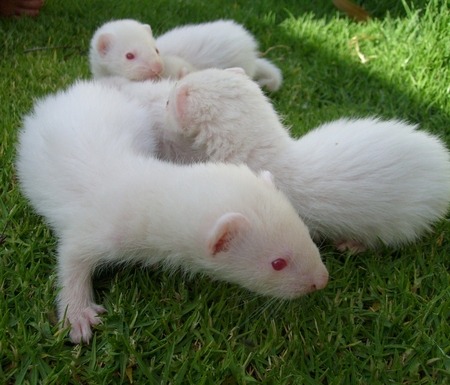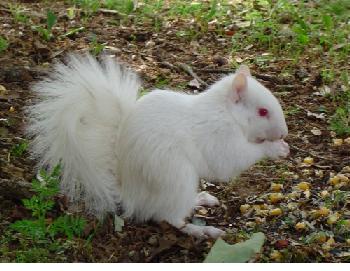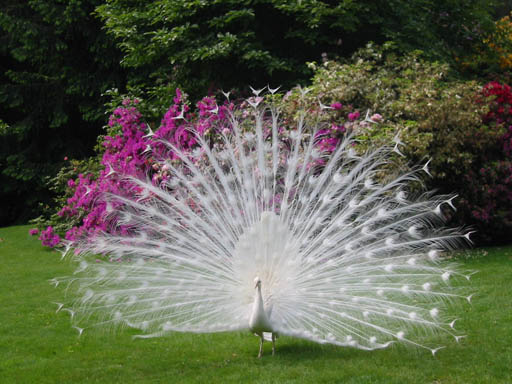|
|
|---|
Wednesday, June 9, 2010
Unless you have been living under a rock lately, you have probably heard about the big oil spill in the Gulf of Mexico. This spill happened when an oil rig exploded, and then the oil kept squirting up from way down deep in the ocean, and nobody so far has figured out for sure how to stop the oil. The company that owned the oil rig is called BP, which stands for Big Problem, which is what they have right now until they can get the oil to stop.
Having all this oil in the ocean is a Very Bad Thing for the fish and the shrimp and the birds that live around there. And what you mostly see pictures of is the Brown Pelican because it is sort of the "poster bird" of the whole oil spill mess. And also it's the State Bird of Louisiana.
Anyway, I got to wondering about these birds and what they are like when they are not covered up with oil, and after doing some in-depth research, I will share with you what I learned. The fancy, scientific name for the Brown Pelican is Pelecanus occidentalis. There are 8 species of pelicans, and the Brown Pelican is the smallest. Which is not to say that it is a tiny bird, because it can weigh as much as 12 pounds and have a wingspan of 8 feet.
The Brown Pelican lives on the east coast and also on the west coast and also as far south as the mouth of the Amazon River. Mostly, Brown Pelicans like salt water better than fresh water. Which is one thing that makes them different from white pelicans. Also the Brown Pelicans fish by diving straight down from the sky into the water to scoop up a fish in the pouch under their beak, and the other kinds of pelicans don't do this diving thing. The other things that pelicans like to eat, besides fish, are amphibians and crustaceans.
Brown Pelicans are pretty social, so they make their nests with a whole bunch of other pelicans, usually on an island, and this is called a colony. Mostly their nests are just scraped-out places in the ground, but sometimes they put some sticks in a low tree. After they make their nests, they lay three eggs in them. When the baby pelicans hatch out, the parents feed them for the next 8-10 months, and during this time, the babies eat about 150 pounds of fish, which is a whole bunch of fish, if you ask me.
Back in the 1960s, people started noticing that all the pelicans in Louisiana were dying, and after a while, they figured out that this stuff called DDT was killing them. DDT was meant to kill bugs, not pelicans, but it was going through the food chain and it ended up in the pelican eggs, and it made the eggshells so soft that the chicks died before they were even born. So then people made it illegal to use DDT. After that, they brought some pelicans from Florida to Louisiana, and these pelicans were happy and made lots of baby pelicans, so now the pelican is not endangered anymore.
Or at least it wasn't endangered until this Big Problem oil spill happened. Now the scientists are watching the pelicans and all the other birds and fish to see what the oil will do to them. A bunch of pelicans have already died because when they get too much oil on themselves, they can't fly anymore. And also their feathers can't keep their bodies the right temperature, so they can die from being too hot or too cold. And also they can drown. Or they can die from eating the toxic stuff that is in the oil.
Besides that, it's bad for the eggs if they get too much oil on them because if they do, the baby birds can suffocate. And even if the babies hatch out okay, they don't have any feathers to protect them, and their mom and dad might bring oil back to the nest, and the oil hurts the baby chicks' skin. Then pretty soon the chicks will get big enough to start walking around in the oil, just like the adult birds.
So it's a very bad and terrible situation, and nobody knows the answer to how to save all the pelicans, even though some people are trying to do that. Here are a bunch of pelicans at a rescue center that are all waiting to get cleaned off. This photo was taken by a man named Sean Gardner of Reuters.
Mom said I should put in some photo credits today because I stole some of these photos off the internet which are maybe not in the public domain, and we don't want to go to jail. So I will tell you that the photo of the eggs was taken by Matthew Hinton of The Times-Picayune. And the oily pelican picture was taken by Charlie Riedel of the Associated Press. The other photos are okay to use, but if Mom and I get sent to jail, I hope you will come visit us and also bring some yummy dog food with you!
Having all this oil in the ocean is a Very Bad Thing for the fish and the shrimp and the birds that live around there. And what you mostly see pictures of is the Brown Pelican because it is sort of the "poster bird" of the whole oil spill mess. And also it's the State Bird of Louisiana.
Anyway, I got to wondering about these birds and what they are like when they are not covered up with oil, and after doing some in-depth research, I will share with you what I learned. The fancy, scientific name for the Brown Pelican is Pelecanus occidentalis. There are 8 species of pelicans, and the Brown Pelican is the smallest. Which is not to say that it is a tiny bird, because it can weigh as much as 12 pounds and have a wingspan of 8 feet.
The Brown Pelican lives on the east coast and also on the west coast and also as far south as the mouth of the Amazon River. Mostly, Brown Pelicans like salt water better than fresh water. Which is one thing that makes them different from white pelicans. Also the Brown Pelicans fish by diving straight down from the sky into the water to scoop up a fish in the pouch under their beak, and the other kinds of pelicans don't do this diving thing. The other things that pelicans like to eat, besides fish, are amphibians and crustaceans.
Brown Pelicans are pretty social, so they make their nests with a whole bunch of other pelicans, usually on an island, and this is called a colony. Mostly their nests are just scraped-out places in the ground, but sometimes they put some sticks in a low tree. After they make their nests, they lay three eggs in them. When the baby pelicans hatch out, the parents feed them for the next 8-10 months, and during this time, the babies eat about 150 pounds of fish, which is a whole bunch of fish, if you ask me.
Back in the 1960s, people started noticing that all the pelicans in Louisiana were dying, and after a while, they figured out that this stuff called DDT was killing them. DDT was meant to kill bugs, not pelicans, but it was going through the food chain and it ended up in the pelican eggs, and it made the eggshells so soft that the chicks died before they were even born. So then people made it illegal to use DDT. After that, they brought some pelicans from Florida to Louisiana, and these pelicans were happy and made lots of baby pelicans, so now the pelican is not endangered anymore.
Or at least it wasn't endangered until this Big Problem oil spill happened. Now the scientists are watching the pelicans and all the other birds and fish to see what the oil will do to them. A bunch of pelicans have already died because when they get too much oil on themselves, they can't fly anymore. And also their feathers can't keep their bodies the right temperature, so they can die from being too hot or too cold. And also they can drown. Or they can die from eating the toxic stuff that is in the oil.
Besides that, it's bad for the eggs if they get too much oil on them because if they do, the baby birds can suffocate. And even if the babies hatch out okay, they don't have any feathers to protect them, and their mom and dad might bring oil back to the nest, and the oil hurts the baby chicks' skin. Then pretty soon the chicks will get big enough to start walking around in the oil, just like the adult birds.
So it's a very bad and terrible situation, and nobody knows the answer to how to save all the pelicans, even though some people are trying to do that. Here are a bunch of pelicans at a rescue center that are all waiting to get cleaned off. This photo was taken by a man named Sean Gardner of Reuters.
Mom said I should put in some photo credits today because I stole some of these photos off the internet which are maybe not in the public domain, and we don't want to go to jail. So I will tell you that the photo of the eggs was taken by Matthew Hinton of The Times-Picayune. And the oily pelican picture was taken by Charlie Riedel of the Associated Press. The other photos are okay to use, but if Mom and I get sent to jail, I hope you will come visit us and also bring some yummy dog food with you!
0 Comments:
Subscribe to:
Post Comments (Atom)




















